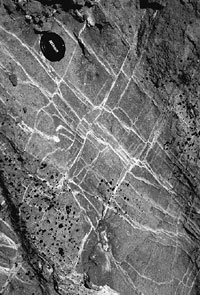  For a review of top seal analysis see Skerlec, G.M. (1999) Evaluating Fault Seal & Top Seal in Exploring for Oil & Gas Traps (Beaumont/Foster eds.), the newest volume in the AAPG Treatise of Petroleum Geology For a review of top seal analysis see Skerlec, G.M. (1999) Evaluating Fault Seal & Top Seal in Exploring for Oil & Gas Traps (Beaumont/Foster eds.), the newest volume in the AAPG Treatise of Petroleum Geology
also
Skerlec, G.M. (1992) Snap, Crackle & Pop: risking top seal integrity: AAPG Annual Convention program abstracts, p. 21 |
Brittle failure is the most common cause of the loss of top seal integrity. Brittle failure may be caused by deformation and/or overpressure (including HC buoyancy). Most important is the necessity for estimating the mechanical properties of the seal at the time of failure. Methods for risking brittle failure include:
 | Incremental Strain Analysis |  | Paleo-Ductility Analysis |  | Mohr Circles and Fracture Gradients |  | Fracture Mechanics |  | Curvature & Second Derivatives |  | Finite-element and Boundary-element Numerical Modeling |  | Analog models including photoelastic and "clay" materials |
The seal capacity of intact top seals is limited by the capillary properties of the seal, the physical character of the hydrocarbons, and seal continuity. Good seals have displacement pressures capable of trapping 1000's of feet of hydrocarbon. Seals with low displacement pressures may traps 0-10's of feet of hydrocarbon. Seal capacity and capillary properties are related to:  | Rock Type |  | Sedimentary Facies |  | System Tracts |  | Log Properties |  | Depth |  | Interfacial Tension, Wettability and Density of the hydrocarbon phase |  | overpressure |
MECHANICAL PROPERTIES OF SEALS CAPILLARY PROPERTIES OF SEALS SEALS COURSE OUTLINE
| | "When top seals are good, they are very, very good; but when they are bad, they are awful." Student Summary |

